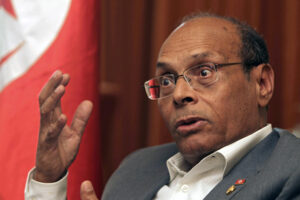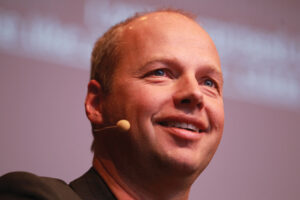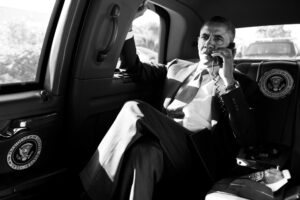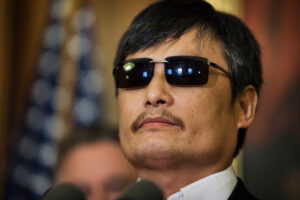
1. AUNG SAN SUU KYI, THEIN SEIN
For showing that change can happen anywhere, even in one of the world’s most repressive states.
Member of parliament, president | Burma
In 2012, the hopes for the Arab Spring began fading into cynicism as the world watched Syria descend into civil war, while the region’s nascent democracies struggled with their newfound freedom. But, meanwhile, one of the most remarkable and unexpected political reversals of our time has unfolded on the other side of the globe: Burma, long among the world’s most repressive dictatorships, began to reform under the leadership of two very unlikely allies.
Aung San Suu Kyi, the soft-spoken, iconic political activist whom devotees call simply “the Lady,” may not seem like an obvious partner for Thein Sein, but she has become one by doing what few legends of her stature can: embracing the messy pragmatism of politics. Although Burma’s struggles are far from over — she has warned that international investment has been too rapid, and ethnic violence is escalating — the willingness of both the Lady and the general to embrace short-term compromise and foster long-term reconciliation in what was only recently one of the world’s most isolated countries is something to celebrate.
Fittingly, Aung San Suu Kyi finally was able to accept her 1991 Nobel Peace Prize in June. She used the occasion to remind the world of those like her, who struggle in the most forlorn places: “To be forgotten too is to die a little. It is to lose some of the links that anchor us to the rest of humanity.” It is a sentiment still felt from Aleppo to Havana, Pyongyang to Tehran, but also, as Aung San Suu Kyi and Thein Sein have shown, one that doesn’t need to be permanent.

2. MONCEF MARZOUKI
For keeping the ideas of the Arab Spring alive.
President | Tunisia
As the spirit of 2011 has faded this year amid religious violence in Egypt and Libya and the bloody sectarian civil war in Syria, Tunisia remains the Arab Spring’s most promising success story, with a contentious but robust political system and an economy that is growing again.
Much of the credit goes to President Moncef Marzouki, who has provided vision and wisdom since taking office in December 2011. At the U.N. General Assembly meeting in September, the doctor-turned-democracy-activist called on the United Nations to declare dictatorship a “disease” and launch an official campaign against autocratic rulers, including the establishment of an international court to arbitrate elections and government legitimacy so as to prevent dictators from taking power in the first place. “It behooves us to implement an ambitious, bold program to eliminate dictatorship in the same way in which we got rid of polio and smallpox,” Marzouki said.
But Marzouki, a former professor of public health, is no starry-eyed idealist. An admirer of Mahatma Gandhi, he devoted himself to human rights early in his career, traveling to India in his youth and South Africa soon after the end of apartheid. As head of Tunisia’s leading human rights organization, he was arrested several times by Zine el-Abidine Ben Ali’s regime and was eventually forced into exile in France, where he remained a prominent figure in Tunisia’s liberal opposition but angered many of his cohorts by working with the Islamist Ennahda movement. Marzouki returned home after Ben Ali’s ouster and was elected president by the country’s Constituent Assembly.
A committed secularist, Marzouki, who is overseeing the writing of a new constitution, insists that Islamist parties must play a role in Tunisia’s governance, though he has also been willing to stand up to them when they overreach. He describes the country’s ultra-conservative Salafi groups as “extremely dangerous” but outside the mainstream. If anyone can guide Tunisia through its transition to democracy — and hopefully create a model for a troubled region — it’s Marzouki, who just might have the right combination of tenacity and levelheadedness to see the country through.

3. BILL and HILLARY CLINTON
For still thinking about tomorrow.
Former president | New York
Secretary of state | Washington
Love them or hate them, America’s ultimate power couple are also its most effective advocates for liberal internationalism: a vision that government can build prosperity at home and promote democracy and development abroad without demonizing the successful or needlessly antagonizing other countries. It’s a different kind of American exceptionalism, based on more than just firepower. And in a U.S. election year that often felt like Randian revanchism vs. opportunistic populism on economics and chest-thumping aggression vs. coldhearted realism on foreign policy, it’s no wonder that America is in the grips of a serious case of Clinton nostalgia.
In an ironic twist, Hillary Clinton — once seen as the calculating cynic to Barack Obama’s idealistic optimist — has emerged as one of the Obama administration’s most forceful advocates for human rights and democracy. Clinton, who was among those who led the push for the United States to intervene in Libya last year, remains a relentless campaigner for women’s rights and economic development, and she has insisted on the promotion of rights for gays and lesbians as an official component of U.S. diplomacy for the first time. But she has also added hardheaded global tactician to her portfolio, as when she spearheaded tense negotiations in China this past spring for the release of dissident Chen Guangcheng (No. 9). With a 66 percent approval rating, she’s a lot more popular than her boss these days and has taken the ups and downs of the Arab Spring — which she accurately predicted at a time when many others succumbed to starry-eyed wishful thinking — as proof that her brand of pragmatic politics harnessed to global star power can be a recipe for American restoration.
As for Bill Clinton, he silenced the doubters at the Democratic National Convention with an impassioned speech on Obama’s behalf that had many pining for the salad years of the 1990s. Forty-eight minutes long and heavy on statistics and his trademark folksy ad-libs as he made the case for economic revitalization, the speech proved once again that no one in American politics does a better job of “‘splainin’ stuff” to the public. He’s still willing to criticize the president, for example, questioning Obama’s assaults on opponent Mitt Romney’s business success. And fittingly, Clinton’s signature post-presidency achievement, the Clinton Global Initiative, is dedicated to the notion that bringing the world’s most powerful and successful people together to work on pressing global problems is more productive than attacking those people. He has been busy on his own innovative projects as well, touring Africa to promote sustainable agriculture and Haiti to discuss alternative energy, periodically dispensing his homespun wisdom along the way. “We have a saying in Arkansas,” he told a group of baffled nurses in Kigali, Rwanda. “If you find a turtle on a fence post, he didn’t get there by accident.”
After four years and a record 112 countries visited (as of writing), Hillary will soon step down as secretary of state. Despite her stated plans to retire from politics as a grandmother-in-waiting, many supporters still haven’t given up hope that the Clintons will once again be in the White House come 2016. Only this time, Bill may be the one at home baking cookies.

4. SEBASTIAN THRUN
For revving up the robot-car revolution.
Computer scientist | Palo Alto, Calif.
Not since Henry Ford’s Model T brought driving to the American masses at the turn of the 20th century has a motor vehicle so promised to revolutionize global transportation. Hydrogen and electric cars once seemed poised to fill that void, but their costs and upkeep have proved prohibitive. Enter the driverless car, the brainchild of Google fellow and Stanford University computer scientist Sebastian Thrun — and now street-legal.
How radical is it? Thrun has in effect reimagined the future of cars — as more about software than hardware. Relying on high-powered sensors and artificial-intelligence software that mimics human decisions, Thrun’s cars can maneuver on and off highways and through rush-hour traffic all by themselves. (One even made it up San Francisco’s famously winding Lombard Street.) The self-driving cars’ growing legion of advocates says the vehicles could completely overhaul the way we think about transportation, making it more efficient, cheaper, greener, and safer. “This is an opportunity to fix a really colossal, big problem for society,” the German-born Thrun says. Robot drivers don’t drink, get distracted, or fall asleep behind the wheel — and their reflexes are measured in milliseconds. Thrun thinks the cars could halve the number of annual road deaths, now at more than 1.2 million worldwide. And because the safer driverless vehicles could be built smaller and lighter, they could also radically reduce fuel use and greenhouse gas emissions.
Today, the driverless cars of 2012 are hitting the streets. In August, Google’s fleet of experimental cars logged its 300,000th mile on public roads. That followed Nevada’s move in March to issue the first license for a self-driving car. As of September, Google’s version of Stanley was also cleared to drive in California, the most populous U.S. state and one that historically sets the standard for how cars are built worldwide. Audi, BMW, Ford, General Motors, Mercedes-Benz, Volkswagen, and Volvo are all designing or testing self-driving vehicles now.
Plenty of technical hurdles remain — not to mention the need to update current traffic laws that assume a human driver — before the cars are produced for a mass market. Still, it’s no longer a stretch to imagine that someday soon, if you’re driving on Highway 101 between San Jose and San Francisco, you just might see Thrun finally starting to relax behind the wheel of his robo-powered Prius.

5. BILL and MELINDA GATES
Co-chairs, Bill & Melinda Gates Foundation | Seattle
As a leader of the world’s largest private development organization, Melinda Gates has long impressed development hands by tackling extreme poverty, pioneering vaccinations, and waging a bold campaign with her husband to eradicate polio. Now she’s establishing herself as a powerful force in her own right, taking on the Catholic Church for its conservative resistance to contraception. By 2020, she says, the Gates Foundation will make “affordable, lifesaving contraceptive information, services, and supplies” available to 120 million women in the world’s poorest countries. According to Gates Foundation-funded research, increasing access to contraception could save the lives of more than 100,000 women each year, slashing maternal mortality by nearly one-third.
Gates, a practicing Catholic, firmly disagrees with the Vatican’s longstanding opposition to contraception and argues that improving access to it is vitally important for public health — and she has personally and more or less single-handedly vowed to “get this back on the global agenda.”
“This will be my life’s work,” she told the Guardian in July. And she has the funds to do it: By 2020, she announced this year, the Gates Foundation will invest $560 million in improving access to birth control, and it plans to raise roughly $4 billion from outside donors. Most will be spent in South Asia and sub-Saharan Africa, where access to contraceptives is not widespread and maternal and infant mortality rates are devastatingly high. Contraceptive use already prevents 272,000 maternal deaths per year, but millions of women around the world still lack access to modern family planning — precisely the void Gates has taken bold steps to fill.
A perennial FP Global Thinker for the enormous scale and ambition of his efforts to finance — and reimagine — global health and development, Bill Gates earns a mention this year for investing in … toilets. Don’t snicker. It’s an urgently worthy cause: 2.5 billion people — or nearly 40 percent of the world‘s population — lack proper bathroom sanitation, leading to the spread of diarrheal diseases that claim the lives of 1.5 million children each year.
To combat it, his Gates Foundation has invested nearly $150 million in programs that improve global sanitation, hosting an engineering competition to develop a “super-toilet” that’s inexpensive to build and maintain and that doesn’t require a water or sewage system. It’s a simple concept but one that Gates, the man whose innovations helped transform personal computing software, says will “revolutionize” sanitation in the developing world as well as in wealthy countries. The winning design, from the California Institute of Technology, uses a solar-powered electrochemical reactor that kills off microorganisms while producing hydrogen and electricity. The foundation hopes to make a pilot version of the system operational by 2014.
Of course, sanitation is just one sideline for Gates. Late last year he became the first private citizen to address a G-20 summit, giving a speech on the future of development that cemented his move from “businessman to statesman,” as the Guardian put it. With much of the world looking inward to fix economic messes at home, Gates is filling the development void abroad — from spearheading an ambitious effort to eradicate polio by 2018, with the foundation giving $150 million to the cause annually, to ramping up his push for food security, including committing $2 billion toward fighting hunger over the next five years. Meanwhile, Gates and Warren Buffett (No. 42), who has committed to giving much of his wealth to the Gates Foundation, persuaded 11 more billionaires to join their two-year-old “Giving Pledge,” bringing the tally to an astonishing 92 families who will donate half their wealth to philanthropic causes before they die.

6. MALALA YOUSAFZAI
For standing up to the Taliban, and everything they represent.
Student | Pakistan
The Taliban’s most fearsome enemy in Pakistan isn’t U.S. drones or the military’s tanks: It’s a 15-year-old schoolgirl. Malala Yousafzai’s tool of defiance? Her own bravery in speaking out for the simple idea that girls should have access to the same education as boys. That shouldn’t be a radical notion in 2012, but even as Pakistan bristles with roughly 100 nuclear warheads, up to 60 percent of women are still illiterate and two out of every five girls fail to finish primary school. Challenging the tyranny of those low expectations can get you killed in today’s Pakistan.
In October, as Malala headed home after an exam, a Taliban gunman stopped her school bus and announced that she must be punished for insulting “the soldiers of Allah.” Then he shot her in the head.
Armed only with her convictions and the firm support of her father, who runs a private girls’ school, Malala refused to be silenced. She became a celebrity in Pakistan through her outspoken interviews, chaired a “child assembly” that aimed to expand opportunities for youth in the Swat Valley, and pleaded with late U.S. envoy Richard Holbrooke to help halt the Talibanization of her country. “I shall raise my voice,” she said last year. “If I didn’t do it, who would?”
It’s a lesson in courage that is inspiring others to stand up to the forces of barbarism in their midst. Too bad it took a tragedy to do it.

7. BARACK OBAMA
For redrawing America’s global footprint.
President | Washington
The brainy 44th president is a huge basketball fan, but Barack Obama knows that none of the plays he calls from the Oval Office are slam dunks. “Nothing comes to my desk that is perfectly solvable,” he said in an interview this year. “Any given decision you make you’ll wind up with a 30 to 40 percent chance that it isn’t going to work. You have to own that and feel comfortable with the way you made the decision.”
At home, Obama has done far more to lift the faltering U.S. economy out of the doldrums than his critics will acknowledge, while expanding the social safety net and daring to take on the greatest threat to America’s fiscal well-being: the country’s exploding health-care costs. Abroad, he has curbed his predecessor’s dangerous excesses, though that doesn’t mean retreating from the world. As he never ceased reminding us on the campaign trail, Osama bin Laden is dead; killer drones aggressively patrol the skies over Pakistan and elsewhere in search of al Qaeda targets; and Obama’s decision to lead (from behind!) an international coalition against Libyan despot Muammar al-Qaddafi created the strange paradox of an avowedly pro-American Arab country awash in armed militias.
But Obama, ever the cautious realist, has been a careful steward of American power. This year has seen the pullout of tens of thousands of U.S. troops from Afghanistan, the theater of America’s longest war. The president has also been wary of getting entangled in the even bloodier sectarian conflict in Syria, refusing to contemplate a Libya-style intervention, and he has wisely adopted a low-key approach to Egypt as it struggles to preserve its newly won democratic freedoms amid an Islamist resurgence.
Whoever sits in the Oval Office in the years ahead will find it hard to break away from Obama’s more restrained view of America’s role in the world — especially now that he has four more years to follow through on his promise to end the wars of the post-9/11 decade.With the president’s determination to “chip away” at global problems and make America’s allies part of the solution, he has conclusively put cowboy diplomacy out to pasture.

8. PAUL RYAN
For doubling down on the debt crisis.
Congressman | Washington
Repeal Obamacare. Lower income tax rates and simplify the tax code. Cut Medicaid by a third and make it a state-controlled block-grant program. Overhaul Medicare by giving beneficiaries money to buy competing public and private health plans. Reduce non-entitlement spending to its lowest level since World War II. And save $5 trillion in the process.
These are the bold ideas contained in Paul Ryan’s austere budget proposal, which the congressman from Wisconsin has gradually persuaded Republican thought leaders, lawmakers, and presidential candidates to support in an effort to shed the reputation for fiscal profligacy that the Republican Party earned under President George W. Bush. “To find a parallel to the way Ryan has so thoroughly seized control of the Republican agenda and identity, you have to go back at least to Gingrich in his nineties heyday, or possibly to Reagan,” New York magazine marveled last spring.
In the 2012 presidential election, contender Mitt Romney didn’t just champion Ryan’s ideas — he tapped the 42-year-old libertarian-leaning lawmaker as his running mate, catapulting the debate over the size and scope of the U.S. government to the top of the political agenda. “The choice is whether to put hard limits on economic growth or hard limits on the size of government, and we choose to limit government,” Ryan declared during his speech at the Republican National Convention, where organizers prominently displayed a humming national debt clock.
Ryan’s anti-deficit jihad has global implications too. He has embodied his party’s internal struggle over defense spending, voting for automatic defense cuts to trim the deficit while opposing reductions in military spending. “Letting budgetary concerns drive national-security strategy means choosing decline,” Ryan declared in his budget, proposing cuts that would effectively slash funding to entities such as the U.S. Agency for International Development and the State Department — but not the military — by nearly $5 billion. We may not see Ryan’s dramatic ideas enacted now that his ticket has lost the election. But they might very well prove prescient.

9. CHEN GUANGCHENG
For envisioning a China with the rule of law.
Legal activist | New York
A year ago, Chen Guangcheng was living under house arrest in the small Chinese village of Dongshigu, unable to travel or receive visitors and subject to constant harassment by the local authorities. Today, he is a global human rights icon, living with his family in New York’s Greenwich Village and free to study and go where he pleases — though uncertain about whether he will ever be allowed to return to his homeland.
Chen, a self-taught lawyer who has been blind since early childhood, first came to prominence in 2005, when he brought a class-action lawsuit alleging that local authorities had forced women in his region to undergo forced abortions and sterilizations as part of their adherence to China’s one-child policy. He was imprisoned for four years for his temerity and then detained in his home, where he faced regular physical abuse. As his fame grew within China, futile attempts to break past the phalanx of guards near his house became a popular method of protest. He soon was adopted as an international cause célèbre, with everyone from U.S. Rep. Chris Smith to actor Christian Bale seeking to visit.
Chen shocked the world in April when he made a daring, next-to-impossible escape, climbing over the wall surrounding his house (breaking his foot in the process) and catching a ride some 350 miles to Beijing, where he took refuge in the U.S. Embassy. After a tense, days-long diplomatic standoff closely involving Secretary of State Hillary Clinton (No. 3), a deal was struck under which Chen would be allowed to travel to the United States to study. Now at New York University, Chen has embraced his new role as an evangelist for human rights, making the case that incremental change — one village or even one person at a time — can eventually transform a superpower. Against all odds, he remains optimistic, believing that China, taking a cue from Japan and South Korea, must “learn Eastern democracy.” He even thinks it’s inevitable: “Nobody can stop the progress of history,” he says.

10. DAVID BLANKENHORN, NARAYANA KOCHERLAKOTA, RICHARD A. MULLER
For changing their minds.
Activist, economist, physicist | New York, Minneapolis, Berkeley, Calif.
Flip-flopping gets a bad rap. Yes, it can be depressing to hear politicians cynically reverse strongly held positions from one election cycle to another. Sometimes, however, when a particularly forceful and articulate voice in a policy debate switches sides, it can be the most effective way to shift the entire conversation.
David Blankenhorn may not have been the most high-profile gay marriage opponent to have had a change of heart this year — that was President Barack Obama — but he was definitely the most surprising. The founder of the conservative Institute for American Values wrote The Future of Marriage, a 2007 book offering intellectual cover to those arguing that same-sex marriage threatens to undermine the institution of the family. He also served as an expert witness in court defending California’s Proposition 8, which legally defines marriage as being between a man and a woman. This year, however, swayed by the growing support for same-sex marriage, Blankenhorn did a full 180, putting his heresy on display in the New York Times in June. “Whatever one’s definition of marriage, legally recognizing gay and lesbian couples and their children is a victory for basic fairness,” he wrote, prompting an enraged reaction from his former allies.
Monetary policy may not provoke the same visceral emotions as the marriage debate, but it was no less shocking in the economics world when Narayana Kocherlakota, the Minneapolis Federal Reserve Bank’s president, said publicly in September that the Federal Reserve should hold interest rates near zero until unemployment falls below 5.5 percent. Kocherlakota, a lifelong inflation hawk, had been one of the most outspoken opponents of lowering rates and had voted against doing so in 2011. Why did he switch? Facts on the ground, namely little real threat of inflation and the need for jobs, jobs, jobs (in Fed speak: “By increasing monetary accommodation,” he said, “the committee can better meet its employment mandate while still satisfying its price-stability mandate.”) The turnabout was in line with a major shift by the Federal Reserve and its chairman, Ben Bernanke (No. 15), resulting in the new growth-targeted monetary policy known as quantitative easing. Time will tell whether this will kick-start America’s job market or lead to out-of-control inflation.
A closer look at the numbers also changed the mind of Richard A. Muller, a University of California/Berkeley physicist and author of popular science books like Physics for Future Presidents, who had long been the go-to climate-change skeptic for those unsatisfied with sneering Drudge headlines. For years, he argued that widely used climate-change models were flawed because thermometers around the world had been placed too near the pavement and scientists were manipulating the temperature data they used. So Muller, along with his daughter, embarked on his own effort — the Berkeley Earth Surface Temperature project — which automated data analysis to eliminate human bias. Given that they were partly funded by conservative billionaire Charles Koch, who also bankrolls the climate-skeptical Heartland Institute, Muller’s numbers were widely expected to “disprove” global warming. But instead, he had an epiphany: “Call me a converted skeptic,” he wrote, saying that “prior estimates of the rate of warming were correct” and “humans are almost entirely the cause.”
As these three thinkers prove, it’s never too late to change your mind.
…
(Foreign Affairs)
















 Afrikaans
Afrikaans Shqip
Shqip አማርኛ
አማርኛ العربية
العربية Հայերեն
Հայերեն Azərbaycan dili
Azərbaycan dili Euskara
Euskara Беларуская мова
Беларуская мова বাংলা
বাংলা Bosanski
Bosanski Български
Български Català
Català Cebuano
Cebuano Chichewa
Chichewa 简体中文
简体中文 繁體中文
繁體中文 Corsu
Corsu Hrvatski
Hrvatski Čeština
Čeština Dansk
Dansk Nederlands
Nederlands English
English Esperanto
Esperanto Eesti
Eesti Filipino
Filipino Suomi
Suomi Français
Français Frysk
Frysk Galego
Galego ქართული
ქართული Deutsch
Deutsch Ελληνικά
Ελληνικά ગુજરાતી
ગુજરાતી Kreyol ayisyen
Kreyol ayisyen Harshen Hausa
Harshen Hausa Ōlelo Hawaiʻi
Ōlelo Hawaiʻi עִבְרִית
עִבְרִית हिन्दी
हिन्दी Hmong
Hmong Magyar
Magyar Íslenska
Íslenska Igbo
Igbo Bahasa Indonesia
Bahasa Indonesia Gaeilge
Gaeilge Italiano
Italiano 日本語
日本語 Basa Jawa
Basa Jawa ಕನ್ನಡ
ಕನ್ನಡ Қазақ тілі
Қазақ тілі ភាសាខ្មែរ
ភាសាខ្មែរ 한국어
한국어 كوردی
كوردی Кыргызча
Кыргызча ພາສາລາວ
ພາສາລາວ Latin
Latin Latviešu valoda
Latviešu valoda Lietuvių kalba
Lietuvių kalba Lëtzebuergesch
Lëtzebuergesch Македонски јазик
Македонски јазик Malagasy
Malagasy Bahasa Melayu
Bahasa Melayu മലയാളം
മലയാളം Maltese
Maltese Te Reo Māori
Te Reo Māori मराठी
मराठी Монгол
Монгол ဗမာစာ
ဗမာစာ नेपाली
नेपाली Norsk bokmål
Norsk bokmål پښتو
پښتو فارسی
فارسی Polski
Polski Português
Português ਪੰਜਾਬੀ
ਪੰਜਾਬੀ Română
Română Русский
Русский Samoan
Samoan Gàidhlig
Gàidhlig Српски језик
Српски језик Sesotho
Sesotho Shona
Shona سنڌي
سنڌي සිංහල
සිංහල Slovenčina
Slovenčina Slovenščina
Slovenščina Afsoomaali
Afsoomaali Español
Español Basa Sunda
Basa Sunda Kiswahili
Kiswahili Svenska
Svenska Тоҷикӣ
Тоҷикӣ தமிழ்
தமிழ் తెలుగు
తెలుగు ไทย
ไทย Українська
Українська اردو
اردو O‘zbekcha
O‘zbekcha Tiếng Việt
Tiếng Việt Cymraeg
Cymraeg isiXhosa
isiXhosa יידיש
יידיש Yorùbá
Yorùbá Zulu
Zulu